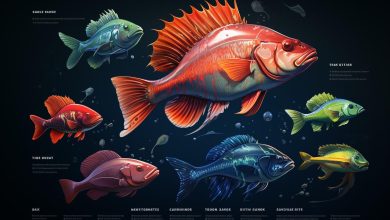Tips For Successful Shore Fishing
Are you looking for an enjoyable way to spend your free time that also allows you to connect with nature? Look no further than shore fishing!
Whether you’re a seasoned angler or just starting out, there are a few tips and tricks that can help ensure a successful day of fishing. In this article, we’ll cover everything from choosing the right location to understanding fish behavior, so you can make the most out of your next shore fishing adventure.
First things first: location is key when it comes to successful shore fishing. While it may be tempting to cast your line in any body of water you come across, taking the time to research and choose the right spot can make all the difference.
Factors like water temperature, depth, and current can all impact where fish are likely to gather. By doing some research ahead of time and paying attention to environmental cues while on-site, you’ll greatly increase your chances of reeling in a catch.
Choose the Right Location
To increase your chances of catching fish, it’s important to scout out the best spots along the coast. Research location options before heading out so you can find areas with high fish populations and good feeding grounds. Look for places where there is structure in the water such as rocks, reefs, or drop-offs. These locations will provide shelter for fish and attract baitfish which in turn draw larger predatory fish.
In addition to researching locations, observe weather patterns before heading out. Fish are more active during certain weather conditions such as overcast days or when there’s a light chop on the water. Wind direction can also play a role in finding productive spots along the shore. Keep an eye out for changes in wind direction or speed, which could indicate a change in current and bring baitfish closer to shore.
Now that you’ve found your ideal fishing spot, let’s talk about using the right gear to improve your chances of success!
Use the Right Gear
So, you think bringing your grandpa’s rusted fishing rod and a plastic bucket from the dollar store is going to cut it? Think again, champ. You need proper gear if you want to reel in anything worth bragging about.
Gear maintenance should be a top priority before heading out for your shore fishing adventure. Make sure your reels are oiled and free of debris, check your lines for any frays or nicks, and sharpen your hooks so that they can easily penetrate the fish’s mouth.
Gear selection is also important when it comes to successful shore fishing. Depending on the type of fish you’re targeting and the location you’re at, different gear may be needed. Research beforehand what kind of tackle and bait will work best for your particular situation.
Additionally, investing in quality gear may cost more upfront but will ultimately save you money in the long run as it lasts longer than cheaper options. Now that you have proper gear, let’s move on to understanding fish behavior.
Understand Fish Behavior
If you want to be a successful shore fisherman, understanding fish behavior is key. You need to know when they’re most active, what their feeding patterns are like, and how predator-prey relationships affect their behavior.
By learning these elements of fish behavior, you’ll be able to better anticipate where the fish will be and what they’ll go for, giving you a greater chance of catching more fish.
So pay attention and watch closely, because mastering these aspects of fishing can make all the difference in your catch!
Learn When Fish are Most Active
Knowing the time of day when fish are most active can greatly increase your chances of catching a big one while fishing from the shore. Here are some tips to help you determine when that might be:
- Early morning and late afternoon tend to be the best times for fishing, as this is when fish are typically feeding.
- Pay attention to weather patterns as well, as overcast or slightly rainy days can also increase fish activity.
Keep in mind that different types of fish may have different feeding patterns, so it’s important to research what species you’re targeting and adjust your fishing schedule accordingly.
By understanding when fish are most likely to be feeding, you’ll be better equipped to plan your fishing trips and maximize your chances of success. From there, identifying feeding patterns can help take your shore fishing game even further.
Identify Feeding Patterns
To really up your game and catch those big ones from the shore, it’s all about identifying when fish are chowing down. This means analyzing their feeding habits and improving your observation skills.
Take note of the time of day when fish are most active, as well as their preferred food source. Feeding habits analysis involves understanding what type of bait to use for different species of fish, while observation skills improvement means being able to recognize patterns in their behavior.
For example, if you notice a school of fish jumping out of the water at a certain time each day, chances are they’re feeding on something specific during that period. By paying attention to these details, you can increase your chances of landing a catch.
With this knowledge in hand, let’s move on to the next section about paying attention to predator-prey relationships.
Pay Attention to Predator-Prey Relationships
Pay attention to how predators and prey interact in the water, as this can help you understand where to cast your line and increase your chances of reeling in a trophy catch.
The food chain plays a crucial role in determining the feeding patterns of fish. Predators, such as bass or pike, will often feed on smaller fish like minnows or perch. Understanding this relationship can give you insight into where to find these species and what type of bait to use.
Additionally, paying attention to predator avoidance behavior can also be beneficial. When prey species sense danger, they will often scatter and flee from the area. This reaction can create ripples on the surface of the water that may attract predatory fish looking for an easy meal.
Observing these behaviors and casting your line accordingly can lead to more successful fishing trips. Remember, understanding predator-prey relationships is just one aspect of successful shore fishing; next up is practicing patience and persistence!
Practice Patience and Persistence
When it comes to shore fishing, patience and persistence are crucial to your success. To increase your chances of catching a fish, you need to be quiet and avoid sudden movements that could scare them away.
Stay focused and alert, paying close attention to any signs of fish activity in the water. And most importantly, be prepared to wait for the right moment – sometimes it takes time for the fish to bite, but with patience and persistence, you’ll eventually reel in a catch worth waiting for!
Be Quiet and Avoid Sudden Movements
Stay hushed and move slowly to keep the fish from sensing your presence when you’re on the shoreline. The Benefits of Silence and Importance of Stealth can’t be overstated when it comes to shore fishing.
Fish have excellent hearing, so any sudden noise can spook them away. This is why it’s important to keep your voice down, avoid slamming things around, and minimize any unnecessary movement.
To control your movements, try Staying Still as much as possible. If you need to move around, do so slowly and deliberately. Avoid stepping on rocks or twigs that could make a loud noise that will scare off the fish.
Remember that patience is key when shore fishing – you may need to wait for long periods without making any sudden movements until a fish takes the bait. By staying quiet and moving slowly, you’ll maximize your chances of catching a big one!
And speaking of maximizing your chances, the next step is all about staying focused and alert…
Stay Focused and Alert
Keep your mind sharp and stay alert to increase your chances of hooking a big catch while on the shoreline. Here are some tips for staying focused and alert while shore fishing:
-
Take breaks: Standing or sitting in one position for too long can cause fatigue, which can lead to lack of focus. Take short breaks every hour or so to stretch, walk around, and refocus.
-
Use multiple senses: Pay attention to what you see, hear, and feel. Listen for splashes or ripples in the water, watch for movement on the surface or along the shore, and feel for any changes in tension on your line.
-
Stay hydrated: Dehydration can cause fatigue and impair cognitive function. Be sure to drink plenty of water throughout your fishing trip.
Remember that mindfulness is key when it comes to successful shore fishing. By staying focused and alert, you’ll be more likely to notice when a fish bites and reel it in before it gets away.
Now that you know how to stay focused and alert while shore fishing, it’s time to learn about being prepared to wait for the right moment.
Be Prepared to Wait for the Right Moment
You’ll need to be patient and ready for the opportune moment while waiting on the shoreline. The importance of timing can’t be emphasized enough when it comes to shore fishing.
Keep in mind that different species of fish may be more active during certain times of day or in specific weather conditions. For example, some fish are more likely to bite during early morning or late evening hours, while others prefer overcast or cloudy days.
Utilizing weather conditions can also play a big role in successful shore fishing. Pay attention to factors such as wind direction and speed, water temperature, and barometric pressure. These elements can affect where fish are located and their feeding patterns. By doing your research and taking note of these details before you head out, you’ll increase your chances of catching something worth keeping.
Remember that patience is key – sometimes waiting for the right moment can make all the difference.
As you wait for that perfect catch, it’s important to follow fishing regulations and ethics.
Follow Fishing Regulations and Ethics
If you want to ensure that your shore fishing activities are carried out responsibly, it’s essential to follow fishing regulations and ethics.
This involves obtaining proper licenses and permits before heading out, as well as releasing any non-targeted fish safely back into the water.
Additionally, showing respect for the environment and fellow anglers is crucial in maintaining a sustainable and enjoyable experience for everyone involved.
Obtain Proper Licenses and Permits
Securing the necessary licenses and permits is essential for a fruitful shore fishing experience. There are various types of fishing licenses available, including freshwater, saltwater, and combination licenses. The permit application process may vary depending on your location, but it typically involves filling out an application form and paying a fee.
Obtaining these licenses and permits can provide several benefits such as legal protection if caught without one, access to exclusive fishing areas, and the opportunity to participate in certain fishing events or competitions. Having the proper license allows you to fish within the legal limits and regulations set by your state or country’s department of wildlife. This ensures that you are not unintentionally contributing to overfishing or harming endangered species.
Remember that obtaining a license is not only required by law but also helps protect our natural resources. With this in mind, make sure to obtain all necessary permits before heading out for your next shore fishing adventure.
Once you have obtained all necessary licenses and permits, it’s important to know how to release non-targeted fish safely without injuring them or damaging their habitat.
Release Non-Targeted Fish Safely
When catching non-targeted fish while shore fishing, it’s important to know how to release them safely without causing harm to their habitat or injuring the fish. Non-targeted fish handling is crucial in minimizing environmental impact.
First and foremost, ensure that your hands are wet before touching the fish as dry hands can remove their protective slime layer and make them susceptible to infections. Secondly, use pliers or other tools to gently remove hooks from the fish’s mouth instead of pulling them out with force.
If the hook is too deep to remove easily, cut the line close to its mouth and let it swim away with the hook still inside. This may seem counterintuitive, but a rusting hook will eventually dissolve within a few months and cause less harm than trying to forcefully extract it from the fish’s throat.
Lastly, always return non-targeted fish back into their natural habitat as quickly as possible after handling them carefully. By following these guidelines, you can minimize any negative effects on marine life while enjoying your shore fishing experience.
Respect for the environment and fellow anglers should always be at the forefront of your mind when engaging in recreational fishing activities. It’s not just about catching big fishes but also preserving aquatic ecosystems for future generations.
With this in mind, we’ll discuss some tips on how you can show respect for both nature and people around you while shore fishing.
Respect the Environment and Fellow Anglers
As we venture out to catch some fish, let’s keep in mind the importance of respecting our environment and fellow anglers. Fishing is a popular recreational activity that requires us to be mindful of the impact we have on the environment.
To ensure that future generations can enjoy fishing as much as we do, it’s essential to leave no trace behind and minimize any negative impacts on wildlife and their habitats. Here are four tips to help you respect the environment and your fellow anglers while shore fishing:
- Pack out all trash: Always bring a garbage bag with you, so you can properly dispose of any trash or litter that may accumulate during your trip.
- Keep noise levels down: Be mindful of other anglers nearby who may also be trying to enjoy their time on the water by keeping noise levels at a minimum.
- Share spots: While it may be tempting to keep your favorite fishing spot secret, sharing knowledge of good fishing locations can help prevent overcrowding in one area.
- Respect wildlife: Avoid disturbing animals and their habitats by keeping a safe distance and not leaving any bait or tackle behind.
By following these simple guidelines, we can do our part in preserving natural resources for future generations while enjoying our time fishing along the shorelines.
Conclusion
Congratulations! You’ve learned some valuable tips for successful shore fishing.
Remember, finding the right location is key. Just like a bee looking for nectar, you must search for the sweet spots where fish are most likely to be found.
With your trusty gear in hand and an understanding of fish behavior, you can cast your line with confidence. But don’t forget, patience and persistence are essential.
Like a farmer tending to their crops or a sculptor chiseling away at stone, success takes time and effort. And as you reel in your catch, remember to follow fishing regulations and ethics.
Respect the environment and wildlife around you. So go forth and conquer the shores!
May your lines always be tight, may your coolers always be full, and may you continue to deepen your love for this timeless pastime of shore fishing.



